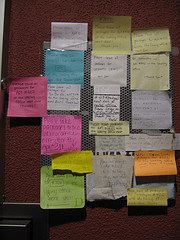This morning I was having breakfast with Esteve Fernández and Jamu Kakar and Jamu mentioned a friend who’s heavily into Sudoku. I mentioned that there are several mobile apps that let you take a picture of a Sudoku puzzle and then solve it for you. I also said “Fluidinfo has an object for every Sudoku puzzle”.
I thought I’d write a very short blog post to illustrate this. So I took the Sudoku puzzle from the Wikipedia entry and made a Fluidinfo object for it. I read the cells of the puzzle left-to-right, top-to-bottom, and used a hyphen to indicate an empty cell in the starting configuration. Written as a single string of characters, that’s 53--7----6--195----98----6-8---6---34--8-3--17---2---6-6----28----419--5----8--79. I used the Fluidinfo Explorer to create an object in Fluidinfo with that as the about value. Then I put a tag called terrycojones/solution onto that object, with value 534678912672195348198342567859761423426853791713924856961537284287419635345286179, which is the correct solution to the puzzle, again read left-to-right, top-to-bottom.
This illustrates a few things. Firstly, Fluidinfo really does have an object for all Sudoku puzzles (created as needed, of course). Second, I’ve established a convention for the about tag value to represent those things. I could have done this in many different ways, and the solution I chose may not be the best. If I were intending to add information about lots of Sudoku puzzles, I would publish my choice and encourage others to follow it (which anyone could do, since any Fluidinfo user may create an object with any about tag – if the object already exists it’s no problem, you just get the already existing object). Third, the terrycojones/solution tag I put onto the object may not be of much use to the wider world. But, I could give other people (or applications) that I trust write permission for that tag so they could tag the objects too. Fourth, if I thought those solutions were worth something, I could make the tag unreadable by default and try to sell access to it (i.e., allow only those who paid me to have read access).
Finally, this illustrates the simple way in which isolated activities, like individually solving a puzzle, can be made social through shared writable storage. If I used a Sudoku application that tagged the shared object with some subset of terrycojones/solved or terrycojones/working-on-it or terrycojones/too-hard or terrycojones/solution-time tags, and others used that application too, solving Sudoku puzzles would instantly be social. Any Sudoku application could use Fluidinfo to allow you to see puzzles your friends couldn’t do or were working on, it could show you the amount of time your friends took, give you hints, find errors, etc. It’s easy to think of a ton of possible social extensions to the Sudoku world, and these include collaborative efforts.
This is a nice example of how shared writable storage with an object for everything allows formerly isolated actions to easily be made social. I’m planning to write up some more simple examples. There are many of them.

